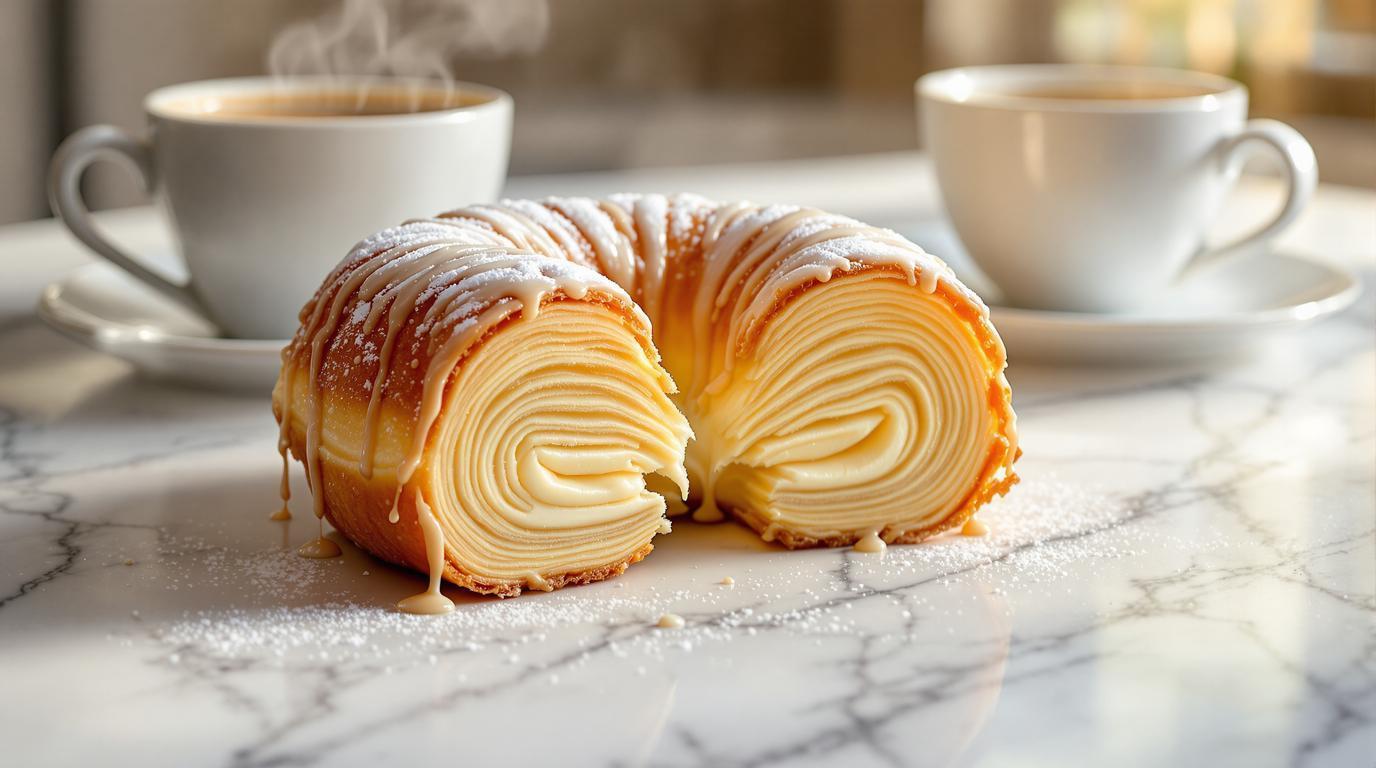The first time I created a proper laminated dough-based treat, I nearly abandoned the project halfway through. The butter was leaking, my kitchen was dusted with flour, and patience was wearing thin. But that moment when I bit into the finished pastry – layers shattering between my teeth, revealing a honeycombed interior with a sweet vanilla aroma – I understood why this technique has endured for centuries. Today I’m sharing my fusion masterpiece: Beignet-Style Cronuts with Vanilla Glaze – where New Orleans meets French patisserie in spectacular fashion.
The Story
While traditional New Orleans beignets deliver that pillowy, yeast-risen comfort under a mountain of powdered sugar, and classic French croissants offer those signature buttery layers, the cronut revolution taught us these techniques could merge beautifully. During my stint at a patisserie in Paris, I witnessed a French chef experiment with laminating beignet dough, and the result was nothing short of magical – a pastry with the soul of a beignet but the sophisticated structure of a croissant. I’ve refined that technique to create something you can replicate at home without professional equipment.
Ingredients Spotlight
For the dough:
- 4 cups (500g) all-purpose flour
- 2½ tsp active dry yeast
- 1¼ cups (300ml) whole milk, warmed to 95°F (35°C)
- ½ cup (120ml) warm water (95°F/35°C)
- 2 large eggs, room temperature
- ⅔ cup (150g) soft unsalted butter (for the dough)
- 1 cup (250g) cold unsalted butter (for lamination)
- 3 tbsp granulated sugar
- 1 tsp fine salt
- Vegetable oil for frying (about 2 quarts/2L)
For the vanilla glaze:
- 1 cup (125g) powdered sugar, sifted
- 1 tsp pure vanilla extract (or seeds from 1 vanilla pod)
- 1-2 tbsp whole milk
Step-by-Step Guide
1. Activate the yeast: Combine warm water, yeast, and a pinch of sugar in a small bowl. Let it sit for 10 minutes until foamy and active.
2. Create the dough: In a stand mixer fitted with a dough hook, combine flour, salt, and remaining sugar. Add the yeast mixture, warm milk, and eggs. Mix on medium speed for 5-7 minutes until smooth and slightly sticky. Add the soft butter in chunks and mix for another 3-4 minutes until fully incorporated.
3. First rise: Cover the dough with a damp cloth and allow it to rise in a warm place (about 75°F/25°C) for 1½-2 hours until doubled in volume.
4. Prepare the butter block: While the dough rises, place the cold butter between two sheets of parchment paper and pound/roll it into a 8×6-inch (20×15cm) rectangle about ½-inch (1cm) thick. Refrigerate until needed.
5. Begin lamination: On a lightly floured surface, roll the dough into a 12×16-inch (30×40cm) rectangle. Place the butter block in the center and fold the dough over it like an envelope, sealing the edges.
6. Create the layers: Roll the dough into a long rectangle and fold it in thirds (like a letter). Turn 90 degrees, roll again, and fold in thirds. Wrap in plastic and refrigerate for 30 minutes. Repeat this process two more times, chilling between each fold.
Chef’s Note: Temperature control is everything in lamination. If your kitchen is warm, work quickly and return the dough to the refrigerator if the butter starts to soften. Cold butter creates distinct layers; melted butter creates a brioche-like texture instead.
7. Shape the cronuts: Roll the laminated dough to a ½-inch (1.5cm) thickness. Using a 3-inch (7.5cm) round cutter, cut circles. Use a smaller 1-inch (2.5cm) cutter to create the center holes. Place on a parchment-lined tray.
8. Second rise: Cover loosely with plastic wrap and let rise for 30-45 minutes until slightly puffy.
9. Fry to perfection: Heat oil to exactly 350°F (180°C) in a heavy pot. Carefully lower cronuts into the oil, frying 2-3 at a time for about 2 minutes per side until deeply golden. Transfer to paper towels to drain.
10. Glaze: Mix powdered sugar, vanilla, and enough milk to create a smooth, pourable glaze. Dip the top of each warm cronut into the glaze, allowing excess to drip off. Place on a wire rack to set.
Expert Techniques
The magic of this hybrid pastry lies in maintaining the integrity of both parent recipes. For beignet-like tenderness, don’t overwork the initial dough. For croissant-like layers, maintain butter temperature – it should be pliable but cold, around 60°F (15°C). During frying, watch the oil temperature closely; too hot and the outside burns before the layers cook, too cool and they’ll absorb excess oil. For the perfect glaze consistency, it should coat the back of a spoon but still flow – like warm honey.
Presentation & Pairing Ideas
Serve these beautiful creations still slightly warm when the contrast between crispy exterior and tender interior is at its peak. For a truly New Orleans experience, pair with café au lait made with chicory coffee. For a modern twist, try a spiced chai latte or even a glass of champagne for special occasions – the acidity beautifully cuts through the richness. You can also enhance these with chocolate drizzle, or draw inspiration from my madeleines recipe and add citrus zest to the glaze.
While this fusion creation requires patience and precision, the result is genuinely spectacular – a celebration of two iconic pastries that brings together the comfort of American doughnuts and the artistry of French patisserie. Make it once and you’ll understand why some kitchen projects, despite their complexity, are absolutely worth the effort. The next time you have a special breakfast or brunch, skip the quick recipes and dive into this rewarding culinary adventure – your guests will be talking about these cronuts for years to come.
